Authorization Letter to Encash Check
Subject: Authorization Letter to Encash Check
[Date]
[Recipient Name]
[Bank Name]
[Address]
Dear [Recipient Name],
I, [your name], hereby give my written authorization to [Mr. John] to encash check number [123456] on my behalf.
Enclosed with this letter are copies of my personal identification for your reference. You may also contact me at any time if necessary.
Thank you for your cooperation and understanding.
Sincerely,
Formal Authorization Letter to Encash Check
Subject: Authorization to Encash Check
Dear Sir/Madam,
I, [Your Full Name], hereby authorize [Authorized Person’s Full Name], bearing ID number [ID Number], to encash the check issued in my name with check number [Check Number], dated [Date], drawn on [Bank Name]. Due to my [reason, e.g., unavailability, illness, travel], I am unable to appear in person to encash the said check.
Please find attached a copy of my valid ID and the ID of the authorized person for your verification and record purposes. Kindly extend your assistance to [Authorized Person’s Name] in completing this transaction smoothly.
Thank you for your understanding and cooperation.
Sincerely,
[Your Full Name]
[Your Signature]
[Contact Information]
Simple Authorization Letter to Encash Check
Subject: Permission to Encash My Check
Dear [Bank Manager’s Name],
I am writing to authorize [Authorized Person’s Full Name] to encash my check number [Check Number] from your branch, as I am unable to visit personally at the moment. Attached are copies of our valid IDs for verification.
Please assist them in this matter. Thank you for your help.
Sincerely,
[Your Name]
Business Authorization Letter to Encash Company Check
Subject: Authorization to Encash Company Check
Dear [Bank Manager’s Name],
This is to authorize [Authorized Employee’s Full Name], an employee of [Company Name], holding ID number [ID Number], to encash the company check number [Check Number] dated [Date] on behalf of our organization. This authorization is issued due to the unavailability of the undersigned.
Attached are copies of the employee’s ID and the company identification for your reference. Kindly accommodate the transaction accordingly.
Thank you for your kind assistance.
Sincerely,
[Your Name]
[Your Position]
[Company Name]
Casual Authorization Message to Encash Check
Subject: Authorization for Check Encashment
Hi [Bank Representative’s Name],
Hope you’re doing well. I’m authorizing [Authorized Person’s Name] to encash my check number [Check Number] for me since I can’t make it to the bank today. I’ve attached our IDs for your reference.
Thanks a lot for your help!
Best,
[Your Name]
Authorization Letter for a Family Member to Encash Check
Subject: Authorization for Family Member to Encash Check
Dear [Bank Officer’s Name],
I, [Your Name], hereby authorize my [relation, e.g., brother/sister/spouse], [Authorized Person’s Name], to encash my check number [Check Number] dated [Date] at your branch. I am unable to do so personally due to [state reason briefly].
Enclosed are copies of both our IDs for verification. Kindly allow [him/her] to complete the transaction on my behalf.
Thank you for your consideration.
Yours truly,
[Your Name]
Authorization Letter for Check Encashment Due to Illness
Subject: Authorization to Encash Check Due to Medical Condition
Dear [Bank Manager’s Name],
I am currently under medical care and unable to visit your branch. Therefore, I am authorizing [Authorized Person’s Full Name], holding ID number [ID Number], to encash my check number [Check Number] on my behalf.
Enclosed are copies of my identification, medical certificate, and the ID of the authorized person. Kindly extend your assistance and ensure the process is completed smoothly.
Thank you for your kind understanding.
Sincerely,
[Your Name]
Authorization Email for Urgent Check Encashment
Subject: Urgent Authorization to Encash Check
Dear [Bank Name] Team,
This email serves as my authorization for [Authorized Person’s Full Name] to encash check number [Check Number] on my behalf. I am out of town and unable to do this personally.
Please verify the attached identification documents for both of us. I appreciate your urgent attention to this matter.
Kind regards,
[Your Name]
[Contact Information]
Official Authorization Letter for Check Encashment of Deceased Person’s Check
Subject: Authorization to Encash Check of Late [Deceased Name]
Dear [Bank Manager’s Name],
I, [Your Name], legal heir and representative of the late [Deceased Name], hereby authorize [Authorized Person’s Name] to encash the check number [Check Number] issued in the name of the deceased. The required legal documents, including the death certificate and proof of relationship, are attached for verification.
Please process the request in accordance with bank policy. We appreciate your assistance during this sensitive time.
Sincerely,
[Your Name]
Authorization Letter for Check Encashment by Company Accountant
Subject: Authorization to Encash Check on Behalf of Company
Dear [Bank Manager’s Name],
This letter authorizes our company accountant, [Authorized Person’s Name], to encash check number [Check Number] drawn under [Company Name]. Due to my unavailability, I am delegating this responsibility to the said employee.
Enclosed are copies of the accountant’s company ID and this letter duly signed and stamped by our office.
Thank you for your cooperation.
Sincerely,
[Authorized Signatory’s Name]
[Position]
[Company Name]
Friendly Authorization Letter to Encash Check
Subject: Authorization to Encash My Check
Dear [Bank Officer’s Name],
I hope this note finds you well. I’m authorizing my friend [Authorized Person’s Name] to encash my check number [Check Number] since I won’t be around this week. You can find attached both our IDs for verification.
Please help them with the process. Thank you so much!
Warm regards,
[Your Name]
What is an Authorization Letter to Encash Check and Why is it Needed
An authorization letter to encash a check is a formal document that allows another person to withdraw or claim funds on behalf of the check owner.
It is used when the account holder or payee cannot personally visit the bank due to reasons such as travel, illness, or scheduling conflicts.
This letter ensures that the bank has written consent to release funds to the authorized person safely and legally.
Who Should Write the Letter
The letter should be written and signed by the payee or the account holder whose name appears on the check.
In case of a company check, the letter must be signed by an authorized company officer or signatory.
In rare cases, a legal representative, such as an executor or family member, may also issue it with proper documentation.
Whom the Authorization Letter Should Be Addressed To
These letters are typically addressed to the bank manager or the branch officer where the check will be encashed.
In some cases, if the check is issued by a business or government agency, the letter may be addressed to their finance or accounting department.
It’s best to address it directly to a specific person for smoother verification and processing.
When Should You Write and Send This Letter
You should write the authorization letter when you know you’ll be unable to encash the check personally.
Common situations include:
- Traveling abroad or being out of town
- Being hospitalized or under medical treatment
- Having scheduling conflicts or work obligations
- Assigning a company representative for business checks
- Handling transactions for deceased relatives’ estates
Requirements and Prerequisites Before Writing the Letter
Before writing the authorization letter, ensure the following:
- You have the check details (check number, amount, and date).
- You have the full name and valid ID of the authorized person.
- You can attach copies of both IDs (yours and theirs).
- If required, attach any supporting documents (e.g., medical certificate, power of attorney, or proof of relationship).
- Check the bank’s policy for third-party encashment authorization.
How to Write and Send the Letter
- Begin with a clear subject line stating the purpose of authorization.
- Identify yourself and the authorized person by full name and ID.
- Mention the check number, bank name, and any specific details.
- State the reason you cannot encash it personally.
- Attach ID copies and relevant documents.
- Sign the letter physically if printed, or use a scanned signature for emails.
- Submit it personally or send it via email as per bank instructions.
Formatting and Style Guidelines
- Length: Keep it one page long.
- Tone: Maintain a formal and respectful tone.
- Structure: Subject → Greeting → Body → Closing.
- Attachments: Include ID copies and supporting documents.
- Mode of Sending: Printed for in-person submission or emailed PDF for digital submission.
- Etiquette: Use polite and professional language, avoid slang.
After Sending or Follow-up Actions
Once the letter is submitted, confirm with the authorized person whether the transaction was successful.
If the bank requests additional verification, respond promptly.
It’s wise to retain a copy of the letter and acknowledgment of receipt from the bank for record purposes.
Pros and Cons of Using an Authorization Letter
Pros:
- Saves time and effort for the account holder.
- Allows trusted individuals to handle urgent matters.
- Serves as a legal safeguard for both parties.
Cons:
- Risk of misuse if authorization is not properly limited.
- Some banks may reject third-party encashment without personal verification.
- Delays may occur due to verification procedures.
Common Mistakes to Avoid
- Forgetting to sign the letter or attach IDs.
- Providing incomplete check information.
- Using unclear or vague language.
- Not verifying the authorized person’s credibility.
- Sending the letter to the wrong branch or department.
Tricks and Tips for Writing an Effective Authorization Letter
- Always use the bank’s preferred format if available.
- Clearly state the check number to avoid confusion.
- Keep a photocopy of the letter and check for your records.
- Attach both IDs side-by-side on one sheet for easy verification.
- Keep the tone polite and concise, even if it’s a quick request.
Does It Require Attestation or Notarization
In most cases, an authorization letter to encash a check does not need notarization.
However, some banks or government agencies may require it for large amounts or sensitive transactions.
If you are authorizing someone outside your immediate family, notarization adds a layer of security and authenticity.
Compare and Contrast with Other Authorization Letters
Unlike general authorization letters, this one specifically deals with financial transactions and therefore carries greater risk.
It differs from letters authorizing document pickup or attendance representation because it involves money handling.
A power of attorney may serve as an alternative for repeated or large-value authorizations.
Elements and Structure of the Letter
- Subject Line: Clearly states the purpose.
- Greeting: Addressed to the correct person.
- Body: Contains authorization details, check number, and reason.
- Attachments: Copies of IDs and supporting documents.
- Closing: Includes signature, name, and contact details.
This consistent structure ensures clarity and bank acceptance.
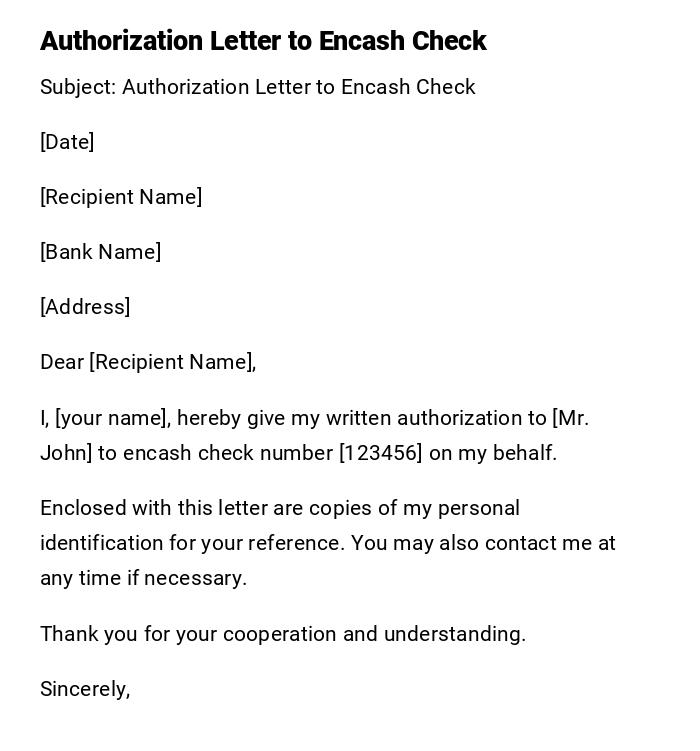
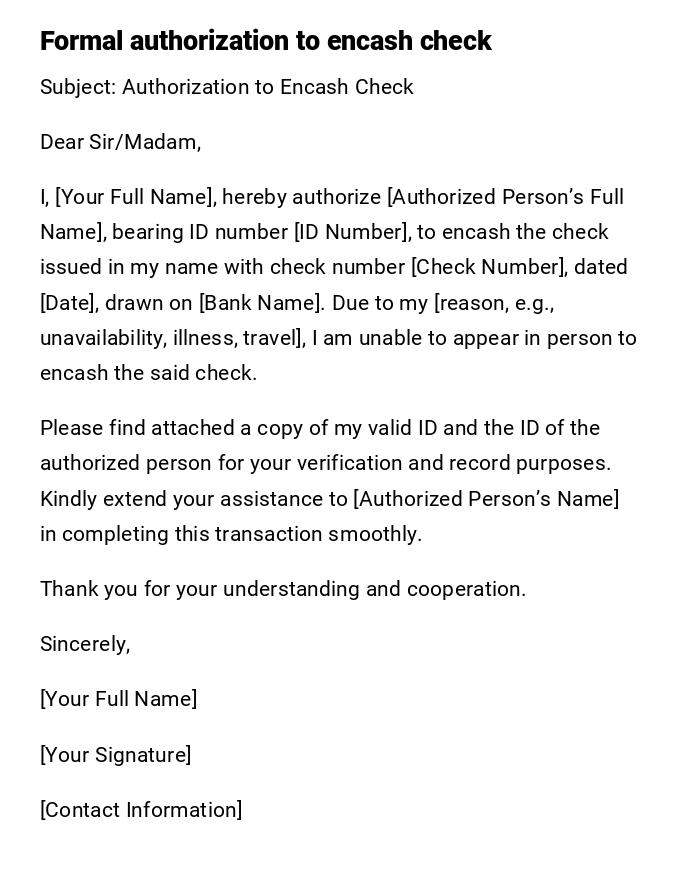
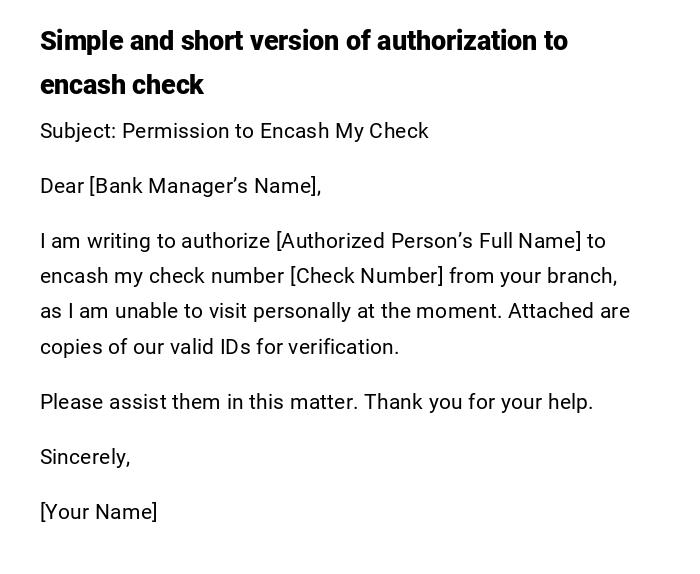
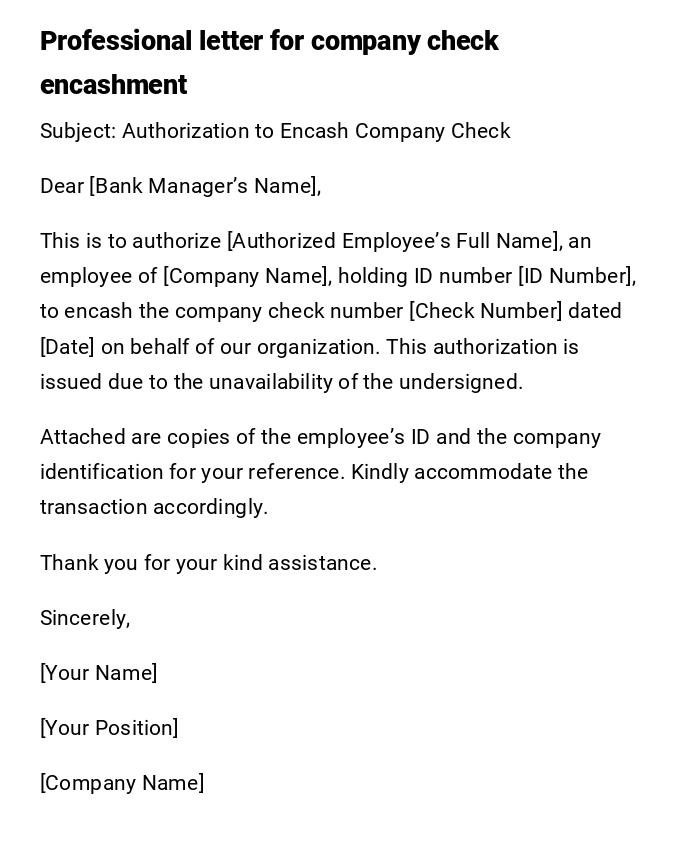
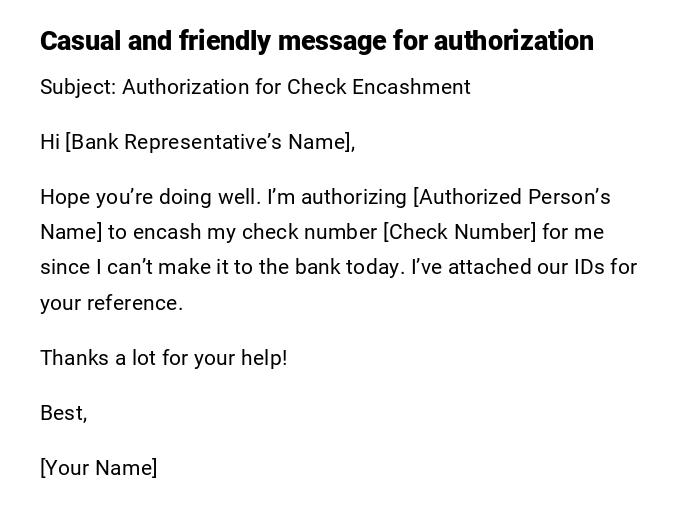
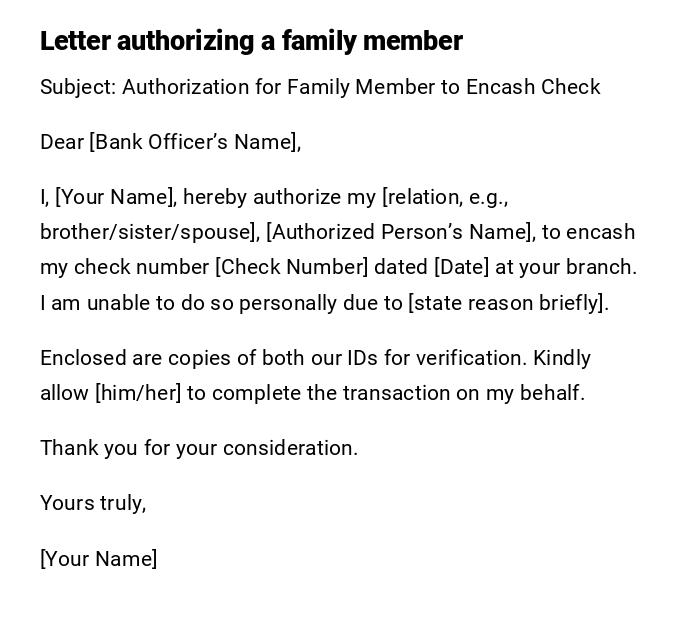
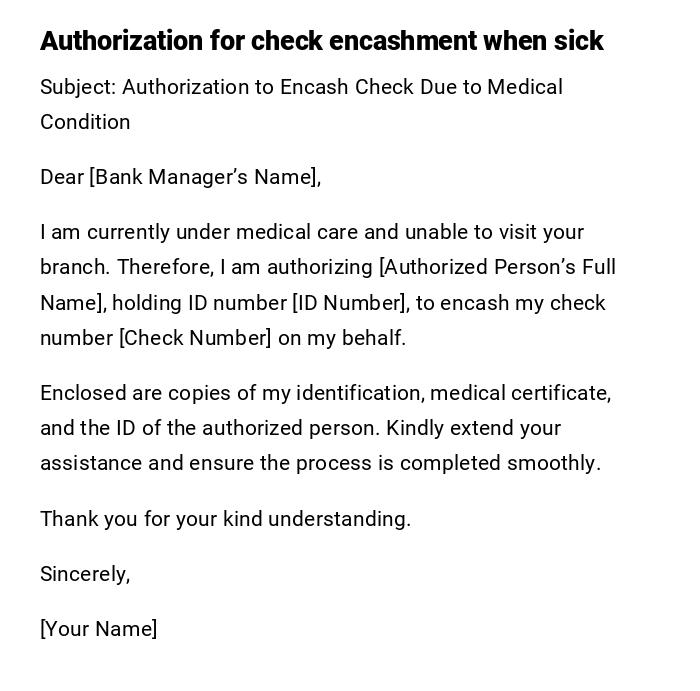
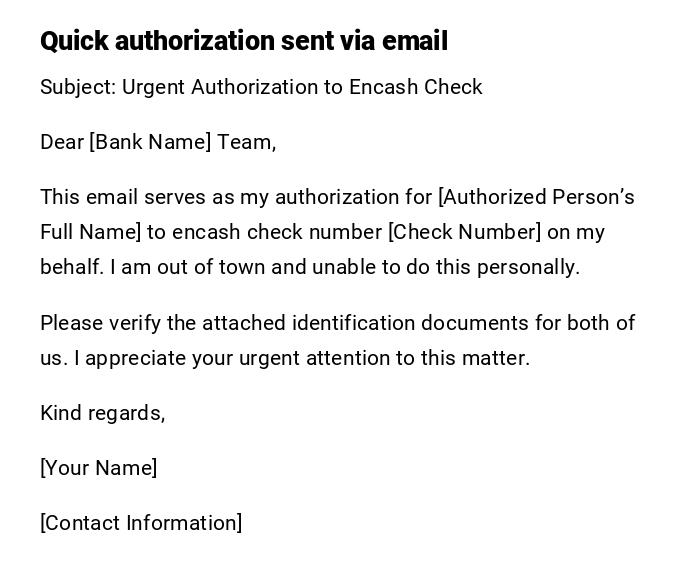
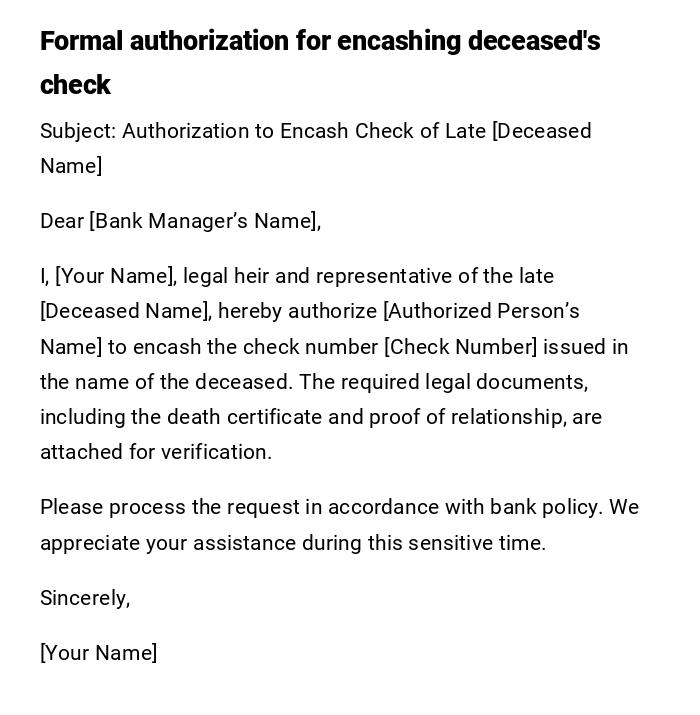
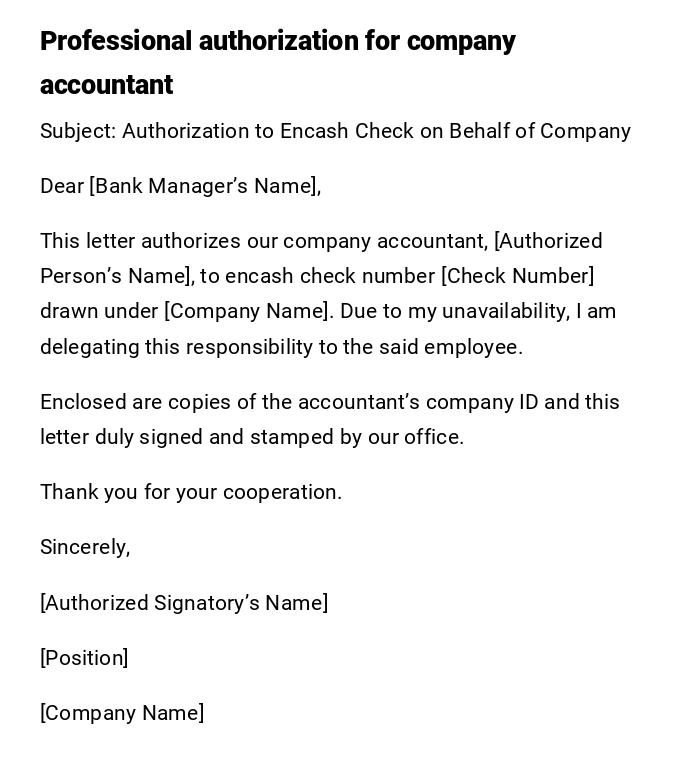
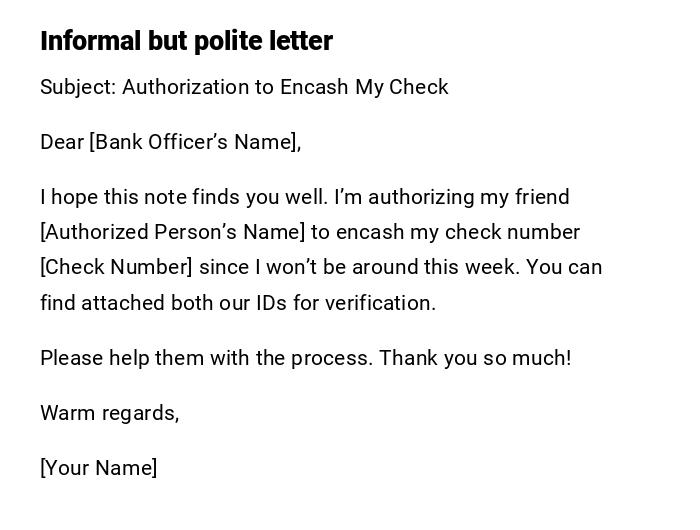

 Download Word Doc
Download Word Doc
 Download PDF
Download PDF